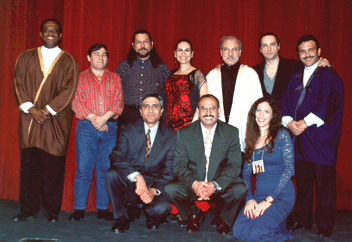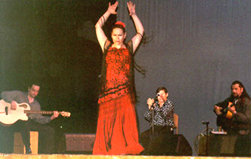

Spirit of Andalucia
Arab and Flamenco Music Concert
Performances By:
Ali Jihad Racy Ensemble
Mimbre Y Vareta Ensemble Flamenco/p>
Saturday, 17 April 1999
The Arab Arts Network (Southern California) presented a unique show called Spirit of Andalucia on 17 April 1999 in Pasadena that combined the beauty of classical Arab music with Flamenco music, singing, and dance. The heavily attended event started with the Ali Jihad Racy ensemble which includes singer Ahmed El-Asmer and percussionist Souhail Kaspar in solo improvisations on the nay, buzuq and oud by Dr. Racy as well as Mawwal and Qasida sung by Mr. El-Asmer. The segments were called Moorish Impressions which included music for the nay (reed-flute) and tar (large frame-drum) evoking the Andalucian musical legacy and devotional ambience of the eastern mystical world; Arab Andalucian Classics which featured taqasim (improvisations) on the 'ud (short-necked lute) followed by layali (vocal improvisations), then classical qasida (sung love poem), and finally two well-known muwashah compositioins (vocal art form rooted in Arab Spain). The Medley in Maqam Nahawand featured taqasim on the buzuq (long-necked lute) followed a series of vocal improvisations and compositions consisting of muswashahat and qudud (song genre typical of Aleppo, Syria). The second segment featured the Mimbre Y Vareta Ensemble Flamenco composed of Pedro Cortes, Flamenco Guitarist, La Conja, Flamenco Dancer & Singer, Sean Kupisz, Bass Guitar and Cajón, and Manolo Segura, Flamenco Singer. They performed Bulerias, a song and dance typically performed in Gypsy weddings and Lepricano, a Tangos Rumba instrumental, as well as a solo song by Manolo Segura and Olas Del Mar, a song and dance from the province of Cadiz.

The exciting second half of the concert combined the two ensembles in an unusual simultaneous performance in both Arabic and Spanish in complete harmony. The large crowd was moved to their feet demanding encores. The segment was comprised of a series of melodic and rhythmic improvisations and dance deriving elements from both Arab and Spanish Flamenco repertoires and blending a wide variety of instrumental timbres and compositional techniques. This section highlighted the spontaneous creativity characteristic of both traditions. The fusion illustrated the stylistic elements shared by the two cultures as well as the unique artistry of the featured performers.
Andalucia is in the southern part of Spain, the region where Flamenco was born. Although Spain has many different types of folk dance and music, Flamenco is typical to Andalucia only. Under the long rule of the Arabs, a style of music and poetry prospered to form a basis for classical music of the Arabs. Andalucia was characterized by multi-cultural arts through the mixing of the Christian, Hebrew, Muslim, and Spanish Gypsy cultures. During seven hundred years of Arab rule, Andalucia became a center of learning and arts absorbing the influence of the divergent cultures of the dominant Spanish population with Arabs, Jews, and Gypsies. A vibrant musical heritage developed and, to this day, forms of classical Arab music reflect this legacy. Flamenco comes from this same mix of influences, and combines music and dance in support of a body of songs known as "cantes". This concert brought both traditions together in a unmatched musicalexperience.
The event was co-sponsored by the Lila Wallace Reader's Digest Fund and the Department of Ethnomusicology at UCLA, and was supported by "Turath.Org" and the Arab Community Center for Economic and Social Services (ACCESS). The Arab Arts Network is a national grouping of artists and art enthusiasts aiming to promote Arab arts and create new audiences in the United States.